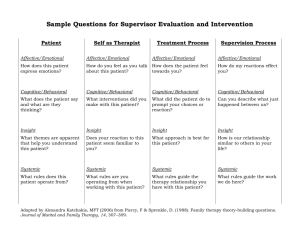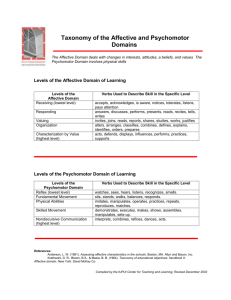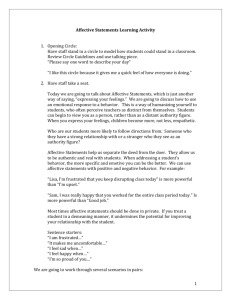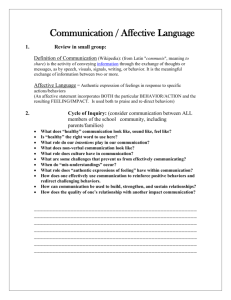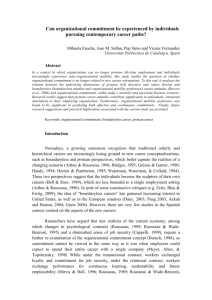Affective Management in a Challenging Environment
advertisement
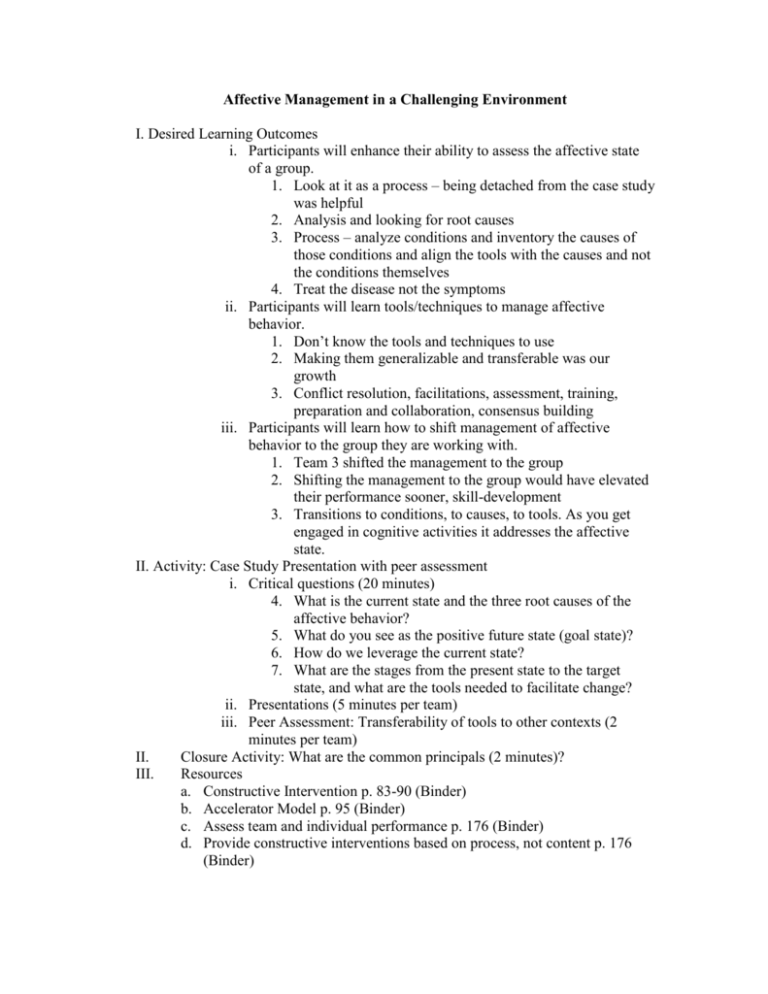
Affective Management in a Challenging Environment I. Desired Learning Outcomes i. Participants will enhance their ability to assess the affective state of a group. 1. Look at it as a process – being detached from the case study was helpful 2. Analysis and looking for root causes 3. Process – analyze conditions and inventory the causes of those conditions and align the tools with the causes and not the conditions themselves 4. Treat the disease not the symptoms ii. Participants will learn tools/techniques to manage affective behavior. 1. Don’t know the tools and techniques to use 2. Making them generalizable and transferable was our growth 3. Conflict resolution, facilitations, assessment, training, preparation and collaboration, consensus building iii. Participants will learn how to shift management of affective behavior to the group they are working with. 1. Team 3 shifted the management to the group 2. Shifting the management to the group would have elevated their performance sooner, skill-development 3. Transitions to conditions, to causes, to tools. As you get engaged in cognitive activities it addresses the affective state. II. Activity: Case Study Presentation with peer assessment i. Critical questions (20 minutes) 4. What is the current state and the three root causes of the affective behavior? 5. What do you see as the positive future state (goal state)? 6. How do we leverage the current state? 7. What are the stages from the present state to the target state, and what are the tools needed to facilitate change? ii. Presentations (5 minutes per team) iii. Peer Assessment: Transferability of tools to other contexts (2 minutes per team) II. Closure Activity: What are the common principals (2 minutes)? III. Resources a. Constructive Intervention p. 83-90 (Binder) b. Accelerator Model p. 95 (Binder) c. Assess team and individual performance p. 176 (Binder) d. Provide constructive interventions based on process, not content p. 176 (Binder) CASE 4 – music at church root causes: strong opinions (disgruntled board member) – music outside comfort zone music director (lack of appreciation for his art) board chairman - facilitator future state: everyone agree on a shared vision of musical worship leverage current state: invoke higher expectations for behavior in church setting resolution plan: invoke higher principles to detach from emotional state Assessment: S: tracing emotions to root causes S: used activity questions to format report I: Tools—facilitation & conflict resolution => align tools to root causes, conditions confounded with causes makes it difficult to transfer; cause was lack of respect based on differing values that were not identified Insight: defining roles can illuminate different causes/patterns that can be used to enrich problem solving/conflict resolution CASE 2 – community service project root cause: fear of saying something because they would look stupid (students) students did not trust teacher with respect to project (students) instructor did not provide performance criteria for students (facilitator) instructor was impatient and proceeded too quickly future state: students are excited, engaged, prepared, creative and implementing plans leverage current situation: use rephrasing of quest speaker, clarifying expectations, clearly connect activity with course requirements tools/techniques: engage passions of students – looks good on resume provide learning objectives & performance criteria for project make a follow-up assignment on WEB CT teacher divide group into teams with specific tasks use preparatory activity Assessment: S: Root causes are fairly orthogonal/independent allowing for mapping of tools to causes S: Analysis of tools available for ‘repair mode’ I: Collaboration between spokesperson/recorder for better flow of story and explanation of discoveries leading to better understanding of opportunities for transferability Insight: Skills used in managing challenging situations are similar to problem solving but involve a host of other skills from the affective domain (conflict management requires more than just raw problem solving ability) CASE 3 – City Council participation by HS students root causes: city council members prejudging students (interpret lack of attendance as apathy), students not able to attend because of inconvenient time/place of council meetings future state: teacher wants to see students actively participate in city council meetings, like other civic stakeholders tools: conduct gap analysis, train stakeholders, switch to assessment mindset, engage in scheduling/planning to insure desired outcome Assessment: S: Problem well-stated and analyzed leading to several tools that can be easily transferred. S: Using values: leverage current set of values to produce buy-in, this can move mountains I: Changing behavior (on part of students) must be brought about through some knowledge acquisition, not just a change in attitude I: Asking an entity to do an assessment without training or performance criteria may not be value-added Insight: Adopting an assessment mindset is a good catalyst for shifting a paradigm Assessment => desire to improve quality; openness to change Debriefing Session: S: Engaging Participants: setting up compelling scenarios that teams found enjoyable I: Engaging Participants: increase frequency of interaction (join tables) S: Responsiveness of Participants: open to interactions, listened to discussion, provided clarification S: Responsiveness of Participants: body language that welcomed participants S: Communication-strong communication of activity outcomes and clear instructions for group activity => high group productivity I: Communication: check spelling to avoid distraction S: Communication: Tone of voice telegraphed confidence and relaxation in role Insight: Once criteria are defined this leads to better discipline that is associated with participant relaxation

